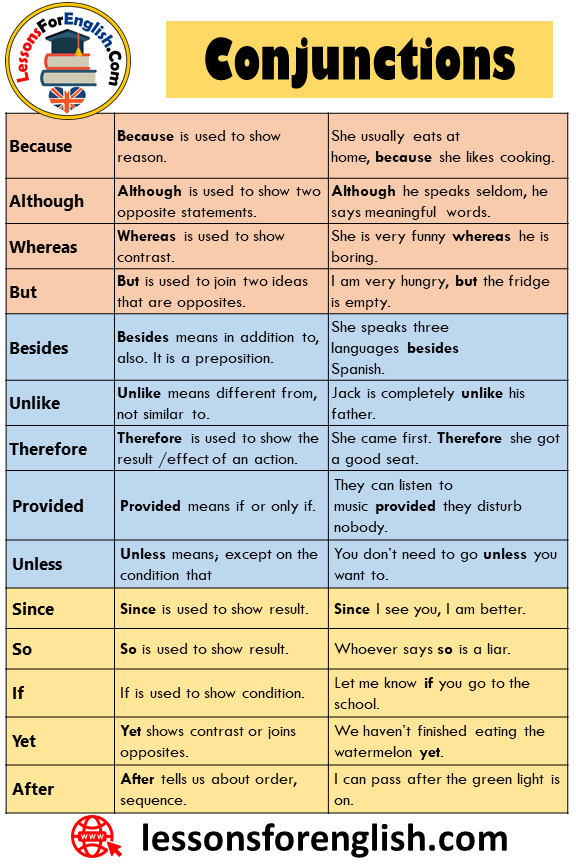100 Conjunctions List, Definitions and Example Sentences
Conjunctions
Conjunctions are words that bind verbs, adjectives, nouns, adverbs in a sentence, as well as sentences. As you learn English grammar rules and grammar issues, you encounter many new things: tenses, verbs, passive-active sentences, adjectives, adverbs, conjunctions, and many more. Moreover, these issues are just some of the first that comes to mind. To speak English most accurately, you try to learn all the rules, but sometimes some titles remain in the background, and the necessary care cannot be given to these issues. Because of this, especially adverbs, prepositions, conjunctions, such as patterns are very confused with each other or the way they are used, and their meanings are easily forgotten. However, these patterns are very important with their ability to add meaning to sentences, provide integrity, and merge. Let’s examine together what each of the conjunctions means and where they are used, which will help you much more than you think.
Use Of English Conjunctions
Conjunctions are called patterns that help connect two words or two separate sentences, giving sentences meaning integrity. As in many languages, this use in English gives you some advantages. By using Conjunctions, you can link two separate sentences related to each other, sort words, or create meaning integrity between two separate sentences. According to its meaning and binding, these patterns can be added to the beginning, middle, or both of the sentences. Conjunctions, called ‘Conjunctions’ in English, are divided into certain classes according to the way they are used.
Coordinating Conjunctions
- These conjunctions help to ensure coordination between two sentences, two nouns, two verbs, two adjectives, or two adverbs.
- When it enters between two sentences, a comma is used at the end of the sentence before it.
- It is preferred to be used in the same direction, to indicate contrasts or to provide options.
- And, but, or, yet, so, nor, and for are examples of these.
Subordinating Conjunctions
- It is used to indicate the relationship between a main and a side sentence.
- If it comes before the main sentence; a comma is used at the end of the main sentence, followed by a side sentence.
- A comma is not used if it comes after the main sentence, i.e. before the side sentence.
- Subordinating conjunctions can be defined by grouping them in the form of the condition, cause, and effect, time, purpose, State.
- Because, when, although, however, as soon as, even if, just as, so that, by the time, while and whereas are examples of these.
Correlative Conjunctions
- Similar conjunctions; connect two objects, subject, verb, or sentence.
- They consist of binary patterns and are found in both sentences.
- Neither…nor… notes references.but also… then, either…or..,both..and.., examples of these.
Conjunctions and Meanings
It can be much easier to establish the relationship between your sentences when describing events when English conjunctions are learned or with a certain grouping. Therefore, you can make patterns more memorable by classifying them according to their meaning and how they are used when working. The most commonly used are.
And
This conjunction is used to connect words and phrases in the same direction. It can be used to add actions that are parallel when connecting sentences, actions that are after each other, and other actions that are the result of one action. For example:
- You like football and basketball.
- Tomas opened the door and drink tea.
- Mike dropped the TV and his mother shouted at him.
- Her office is far, and she has to run for two minutes.
‘And ‘ can be used before the last item of the list, as in many languages. In this use, it is optional to put a comma before the ‘and’ connector. In particular, if you want to indicate that the last two items are not a combined name (such as chips and fish), a comma is placed before the ‘and’ part.
Or
- You don’t like football or basketball.
- Go home, or you will call the mother.
But
‘But’ indicates a contrast, that is, it is used when saying something unexpected according to the first expression. Most of the time, a comma is placed before the’ but ‘ connector.
- Tomas earn lots of Dollars, but Tomas wore an old hat.
Note: When the subject of two sentences is the same, after “or, and, but”, this subject may not be said again, although it will be understood. In this case, no commas are placed:
So
The’ so ‘ connector can be used to specify the result.
- You were late, so you took a special car.
For
‘For’, because it is not used at the beginning of the sentence and is preceded by a comma. For example;
- Melissa became a teacher just after school, for her father was a minister.
Yet
- Garry lives in London, yet your favorite city is New York.
Nor
’ Nor ‘takes the overturned structure, i.e. the expression after the’ nor ‘binding begins with the auxiliary verb, as in the question structure;’ nor ‘ gives a negative meaning.
- Bilica does not play football, nor does he like basketball.
Conjunctions appear in all English language exams. Those who have sufficient knowledge of the English conjunctions table are more successful in the exam. Regardless of the method applied when learning English, it is necessary to work with special care for conjunctions. Highly effective learning methods related to conjunctions are applied in online English pieces of training, and trainees memorize conjunctions much more easily. Information about places of use is reinforced by sentences, mutual conversations, and tests.










0 Comments